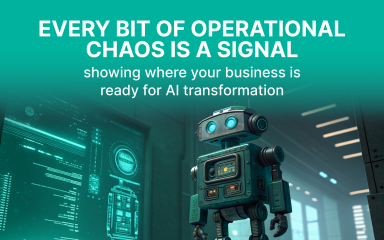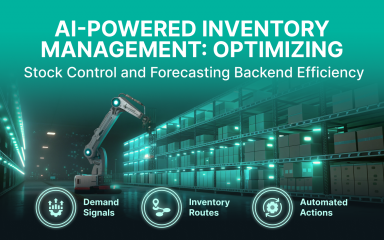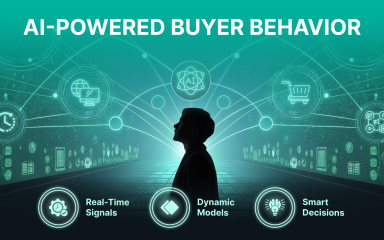How to implement AI in business successfully is the most pressing challenge for digital leaders in 2025. As artificial intelligence (AI) continues to revolutionize industries, businesses across all sectors can leverage AI to gain a competitive advantage, improve operational efficiency, and drive innovation. This guide provides a strategic, step-by-step framework to transition from theoretical interest to a sustainable competitive advantage across your retail operations and is relevant for businesses in various industries. We focus on pragmatic steps for integrating AI into existing systems and driving value.
What Is AI in Business and Why Does it Matter?
AI in a business context refers to the use of computer systems and AI technology to perform tasks that typically require human intelligence, applied specifically to optimize commercial outcomes.
Why AI is Essential for Competitiveness in 2025
AI represents the critical next phase of digital transformation, driven by evolving industry trends that are reshaping how businesses operate. While traditional automation executes pre-defined actions, AI business solutions learn from data to make dynamic predictions or decisions in real-time. For e-commerce, this means leveraging predictive analytics to forecast purchases and generate personalized offers, helping businesses anticipate market trends and customer needs. This is the essence of how to implement AI in business strategy.
According to a report from IBM, companies that successfully implement AI solutions often see significant gains in efficiency and top-line growth. Without an active AI implementation strategy, mid-to-large online retailers risk being outpaced as industry trends and market trends continue to evolve.
| Traditional System (Rules-Based) | AI System (Learning-Based) | Impact on Retail Operations |
| Inventory reorder point is fixed. | Inventory dynamically adjusted based on seasonality and promotions. | Reduces stockouts and holding costs. |
| Customer service uses a fixed FAQ script. | AI chatbots resolve 80% of Tier 1 queries and proactively upsell. | Lowers CX labor costs and boosts sales. |
| Email personalization uses basic history. | Generative AI writes unique, personalized product descriptions. | Increases conversion rates and engagement. |
In short: To successfully implement AI in business, leaders must see it as a shift from pre-programmed logic to continuous, data-driven learning that yields both efficiency and entirely new customer experiences, enabling organizations to stay ahead of market trends and competitors.
The AI in Business Framework: Laying the Foundation for ROI
An effective AI in business framework is a strategic, multi-layered initiative ensuring AI efforts are aligned with KPIs and supported by robust infrastructure. A comprehensive framework integrates AI into business processes, enabling organizations to strategically integrate AI and create new AI applications that drive value and innovation.
Data Readiness & Strategy
Question: What is data readiness and why is it the first step in AI adoption?
Data readiness is ensuring data is clean, labeled, secure, and accessible for model training. Poor data quality is the most common reason for AI project failure. Your strategy must unify siloed data (CRM, web analytics, transaction logs) into a single, structured source.
Use Case Identification & Prioritization
Identifying the right AI use cases for business is paramount, and it begins with aligning AI solutions to specific business needs. Start by targeting high-impact areas in e-commerce: CX (AI shopping assistants), Marketing (personalized recommendations), and Operations (fraud detection). Additionally, leverage AI for market research and to analyze customer behavior, enabling businesses to better understand customer preferences and market trends. The benefits of implementing AI in business are highest when the use case addresses a high-cost pain point, such as reducing the 70% cart abandonment rate, and delivers actionable insights to improve business outcomes.
AI Model Development & Training
The choice is between pre-trained models (LLMs) and custom solutions. For personalized search or fraud flagging, a pre-trained model fine-tuned on your proprietary data is often the fastest route. This defines the necessary expertise and budget.
Integration with Business Systems
A core challenge is integrating AI into existing systems. AI solutions must communicate flawlessly with core platforms—ERP, CRM, and CMS. Seamless AI system integration ensures that predictions instantly trigger actions within your marketing automation platform, while also enabling automating processes to improve efficiency. In particular, AI-driven customer relationship management (CRM) systems provide insights, predict preferences, and streamline communication to deliver personalized, proactive customer support.
ROI Measurement & Optimization
How do you calculate ROI for an AI project?
AI ROI is calculated by comparing project cost (data, talent, infrastructure) against quantifiable business benefits (increased AOV, reduced expense, improved conversion rate). A clear KPI baseline must be set before the pilot to demonstrate financial impact. This helps determine the true ai roi in business.
In short: The AI in business framework provides a structured approach, starting with data quality and moving to high-impact use cases that deliver measurable ROI. This strategy is critical for leaders asking how to implement ai in business sustainably.
Step-by-Step AI Implementation Process
Successfully answering how to implement ai in your business requires a phased, iterative deployment roadmap.
Phase 1: Pilot Project & Testing
A Proof of Concept (PoC) or AI pilot testing is a small-scale, time-bound project validating a high-priority use case. For a retailer, this might be deploying an AI-powered image tagger for 1% of the catalog. It validates technology, refines the problem, and creates internal success. According to Harvard Business School, starting small and proving value quickly is crucial for long-term AI success. This helps us learn how to implement generative AI in business effectively.
Phase 2: Vendor & Technology Selection
Choosing the right partners is vital. Evaluate cloud providers and specialized AI vendors for specific applications. Look for platforms that support open standards to avoid vendor lock-in. Key considerations include the vendor’s experience in your vertical and the platform’s scalability. This phase is crucial for implementing AI in business processes.
Phase 3: Infrastructure, Scaling, and Rollout
This phase moves the validated PoC to production. A scalable AI architecture is non-negotiable, requiring a cloud-first approach to handle compute demands. This is where you implement AI automation in business processes. A gradual, monitored rollout is recommended to manage performance and mitigate unseen risks. This applies to operations of all sizes, from large enterprises to how to implement AI in small businesses.
To successfully figure out how to implement AI in your business, start with a small pilot, choose flexible vendors, and build a cloud-based infrastructure that can scale to handle the entire business operation.
Building AI-Ready Teams: The Human Factor
AI implementation is a people and process challenge. The success of your AI adoption roadmap hinges on your organization’s ability to evolve.
Talent Acquisition & Upskilling
The high cost and scarcity of AI talent make AI team building a strategic priority. While you may need to acquire data scientists and machine learning engineers—who are essential for developing, deploying, and optimizing machine learning models—the most effective strategy involves reskilling existing employees. Building a skilled AI team, including project managers to coordinate efforts, manage workflows, and monitor progress, is essential for handling complexities in AI development. Training domain experts to become proficient “AI users” is often faster and yields better business alignment. The SBA emphasizes that even small companies can start by training existing staff on AI tools.
Cross-Department Collaboration
AI projects are inherently cross-functional. An AI-powered pricing engine requires alignment between IT, Finance, and Marketing. Effective communication bridges the gap between technical possibilities and business realities. Collaboration across departments can also enhance customer engagement through AI, such as by leveraging AI-driven tools to improve customer interactions and satisfaction. This ensures success when implementing AI in business operations.
Leadership & Change Management
AI leadership support must be visible and consistent. Executives must communicate why AI is being implemented and how it will change roles, reducing employee fear and increasing adoption. A formal change management strategy addresses concerns early on.
Best Practices for AI Adoption
To secure the long-term competitive advantage of using AI in business, focus on governance, strategic partnerships, and continuous evolution.
Governance & Compliance
What is responsible AI in business and why is it important?: Responsible AI is a framework ensuring AI systems are developed and deployed ethically, fairly, and transparently, adhering to regulations like GDPR. For retailers, this includes ensuring pricing models are non-discriminatory. Establishing governance and ethical guidelines helps mitigate legal and reputational risks in AI. Clear AI governance policies must be established from day one to manage legal risk and address challenges of implementing AI in business. Adopting ethical AI practices is also essential for maintaining customer trust, as transparency and integrity in AI implementation reassure customers and protect a company’s reputation.
Partner Ecosystem
Leveraging strategic AI partnerships with specialized technology firms and consultants can significantly reduce your time-to-market. Partners provide critical expertise in complex areas like custom LLM fine-tuning or multi-cloud deployments, allowing your internal team to focus on core business strategy.
Continuous Improvement
AI is not a one-time deployment. Models suffer from model drift. A culture of AI optimization requires constant monitoring, regular retraining, and iterative testing to ensure the model remains accurate and aligned with evolving business goals.
AI in Business FAQ
Here are the answers to the most common questions leaders have about AI implementation and value.
- What are some practical AI applications in business?: AI applications in business include a wide range of solutions such as AI chatbots for customer service, computer vision for image recognition and quality control, and inventory management systems that use predictive analytics to optimize stock levels. These applications help businesses streamline operations, improve decision-making, and gain a competitive edge.
- How does AI improve operational efficiency?: AI improves operational efficiency by automating routine tasks, including time consuming tasks like data entry, scheduling, and customer inquiries. By automating routine tasks, organizations can reduce errors, save time, and allow employees to focus on more strategic work.
- What are some common use cases for AI in organizations?: Common use cases for AI include optimizing the supply chain, enhancing supply chain efficiency through predictive analytics, and improving inventory management to reduce stockouts and overstock. Other use cases involve customer service automation, fraud detection, and personalized marketing.
- How does AI help with automating tasks?: AI helps automate repetitive tasks and is especially effective at automating routine tasks such as data entry, appointment scheduling, and responding to customer queries. This automation frees up human resources for higher-value activities and increases overall productivity.
- What is AI implementation in business?: AI implementation in business is the structured process of integrating AI into existing systems, such as machine learning models or generative AI tools, into core operational systems to automate tasks, predict outcomes, or create new content for measurable commercial value.
- How can AI improve operational efficiency and revenue?: AI improves operational efficiency by helping businesses streamline operations through automating repetitive tasks, optimizing logistics, and reducing errors. It increases revenue by enabling hyper-personalized marketing, dynamic pricing strategies, and improving customer experience, which boosts conversion rates. This is how the benefits of implementing AI in business are realized.
- What are the top AI use cases in different industries?: Top AI use cases for business include predictive maintenance in manufacturing, fraud detection in finance, personalized diagnosis in healthcare, and real-time inventory and pricing optimization in e-commerce. This includes how to implement AI chatbots in business for Tier 1 support.
- How do you calculate ROI for an AI project?: ROI for an AI project is calculated by quantifying the benefit (e.g., increased sales, reduced churn, lower labor costs) and subtracting the total cost of the AI initiative (data, talent, software, infrastructure) over a defined period.
- Can AI replace human decision-making?: No, AI does not replace human decision-making; it augments it. AI provides superior analysis and prediction, enabling human managers to make faster, more informed, and strategically complex decisions. It handles the data analysis while humans retain the strategic oversight and ethical judgment.
What’s Next?
The path to integrating AI into your retail business is clear. Establishing a robust AI strategy consultation is the key difference between keeping pace and taking the lead. A tactical-only approach—experimenting without a framework—risks wasted investments and technical debt.
Still unsure how to implement AI in business and need a tailored AI implementation plan for your e-commerce operations? Let’s get in touch to design your future-proof roadmap.











